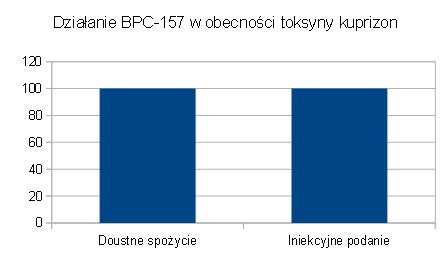Summary: The peptide BPC-157 acts directly on the nervous system, showing both neuroprotective and antidepressant effects. Its broad spectrum of action finds application, among others, in neurotransmission. Keywords: BPC-157, nervous system, cuprizone, toxin, reserpine, GABA, serotonergic transmission, depression List of Abbreviations: BPC - Body Protection Compound; GABA - Gamma-Aminobutyric Acid; MPTP - Prodrug of the neurotoxin MPP+ Materials and Methods: The studies were conducted on laboratory animals, in this case rats.
Effect of BPC-157 on the Nervous System in Experimental Aspects
Study 1
Material:
The study was conducted on rats using the cuprizone toxin, which produces symptoms similar to those of multiple sclerosis or schizophrenia.
Study Procedure:
BPC-157 was administered to rats in drinking water or through injections, in combination with the cuprizone toxin.
Result:
Oral intake of BPC-157 at a dose of approximately 10 µg/kg (0.16 µg/ml in water) shows an effective action, similar to injection at doses of 10 ng/kg and 10 µg/kg. It shows this action in the presence of the cuprizone toxin, which can cause neuronal damage, including demyelination leading to the breakdown of myelin sheaths in the central or peripheral nervous system, without having to reach the brain.
Conclusions:
BPC-157, both in the form of a stable oral salt and in injectable form, shows a protective action on brain tissue (Fig. 1). [caption id="attachment_662" align="aligncenter" width="447"] Figure 1: Level of oral intake and injection showing action at the same level[/caption]
Figure 1: Level of oral intake and injection showing action at the same level[/caption]
Study 2
Material:
The study was conducted on rats using the neurotoxin MPTP and reserpine, which are used to create a Parkinson's disease model.
Study Procedure:
The rats were administered the BPC-157 peptide subcutaneously in the presence of the neurotoxin MPTP and reserpine.
Results:
The effect of MPTP and reserpine toxins was greatly reduced in the presence of the BPC-157 peptide. The range is shown in the following diagrams. (Fig. 2)
[caption id="attachment_664" align="aligncenter" width="833"] Figure 2: The level of MPTP and reserpine toxins is in the range of 0-140, represented as high in the case of Parkinson's disease. When the BPC-157 peptide is involved in the action of the toxins, their level is reduced and falls within the range of 0-60[/caption]
Figure 2: The level of MPTP and reserpine toxins is in the range of 0-140, represented as high in the case of Parkinson's disease. When the BPC-157 peptide is involved in the action of the toxins, their level is reduced and falls within the range of 0-60[/caption]
Conclusions:
BPC-157, as a result of the above study, shows an action that minimizes the symptoms of Parkinson's disease, a neurodegenerative disease that hinders the normal functioning of the organism
Effect of BPC-157 on the Nervous System in Theoretical Aspects
Characteristics of Nootropic Drugs:
Nootropics belong to a group of drugs that should have a therapeutic effect by improving cognitive functions such as memory, concentration, and attention. Active substances belonging to this group can increase motivation or improve motor functions. Nootropic substances include both synthetic and natural preparations. The list of substances recognized as nootropics is constantly evolving, with some preparations being removed and others added. The BPC-157 peptide shows nootropic capabilities as a neuroprotective preparation.
Neuroprotective Action of BPC-157:
The studies presented above allow for the classification of the BPC-157 peptide, both in oral and injectable form, as a preparation with neuroprotective action. Studies have shown that the BPC-157 peptide acts as a protective agent for brain tissue and reduces symptoms of nervous system diseases. Moreover, other laboratory experiments allow conclusions to be drawn about other therapeutic effects of the peptide, such as regeneration of nerve cells, protective action in drug withdrawal syndrome, and even in convulsions that occur with excessive intake.
Influence of BPC-157 on the GABA System
Characteristics of GABA:
GABA, or γ-aminobutyric acid, is one of the main neurotransmitters. Due to its chemical structure, it is classified as an amino acid. The proper functioning of GABA is linked to the action of two main receptors, the ionotropic GABA-A and metabotropic GABA-B. In the human body, the neurotransmitter GABA is responsible for the proper functioning of the nervous system by inhibiting its excessive excitation. The conclusion for such a spectrum of action is that both its deficiency and excess lead to disorders of the nervous system, which is why it is so important to maintain its correct level. Other functions of the neurotransmitter GABA include proper functioning during the body's rest in the sleep phase, help in concentration while preventing distraction. It allows for the calming of the organism, thus eliminating stress and stimulating the production and secretion of growth hormone from the pituitary gland.
BPC-157 and Its Influence on GABA:
The BPC-157 peptide has a direct influence on the regeneration of the GABA system, while simultaneously accelerating the return to homeostasis after addiction or abuse of drugs and substances that directly damage the GABA system. In the example of benzodiazepines, particularly diazepam, it was observed that when administered simultaneously with the BPC-157 peptide, among other things, it reduces the development of drug tolerance, improves drug efficacy, and maintains the homeostasis of the GABA receptor complex. The GABA receptor is shown in the diagram. (Fig. 3) [caption id="attachment_663" align="aligncenter" width="907"] Figure 3: GABA Receptor[/caption]
Figure 3: GABA Receptor[/caption]
Serotonergic Transmission in Experimental Aspects
Material:
The study was conducted on rats, in terms of involvement in the serotonergic system, in relation to a possible brain-gut axis, due to the action of BPC-157 in both areas.
Study Procedure:
The BPC-157 peptide was administered to rats by subcutaneous injection at a dose of 10 µg/kg with simultaneous application of serotonin. The study was conducted for 40 minutes daily over a period of one week.
Results:
The results are visible in several brain areas, including the substantia nigra of the midbrain and the medial anterior olfactory nucleus, with a simultaneous decrease in the hypothalamus, ventral and dorsal hippocampus, and dorsal thalamus. Serotonin synthesis is increased, the increase in serotonin synthesis in the substantia nigra was maintained in the reticular and compact part with administration for one week. With single administration, the decrease in serotonin synthesis was not maintained.
Conclusions:
BPC-157 shows an antidepressant action that results from interaction with the serotonin system.
Serotonergic Transmission in Theoretical Aspects
Concept of Serotonin Syndrome:
Serotonin syndrome is a condition that directly threatens normal functioning and life. It is an undesirable side effect of pharmacotherapy, characterized by symptoms such as changes in mental state, vegetative disorders, or neuromuscular disorders. The occurrence of this syndrome is most commonly associated with analgesic pharmacotherapy that can intensify serotonergic transmission.
Serotonergic Transmission with BPC-157:
According to the above studies, it can be noted that BPC-157 administered peripherally has the ability to cross the blood-brain barrier. The peptide administered together with serotonin allows for bypassing the phase of serotonin syndrome, which directly affects the nervous system and depressive states.
Depression and BPC-157 in Experimental Aspects
Material:
The study was conducted on rats during the forced swimming test (Porsolt test).
Study Procedure:
The rat was placed in a cylindrical container filled with water for a period of 15 minutes. After 24 hours from the first attempt, a second one is performed consisting of placing the animal in the same container for 5 minutes. During this time, the time the animal remains motionless is observed. The immobility of the animal corresponds to depressive states in humans. At the same time, during the study during the forced swimming test, BPC-157 was administered to the rat intraperitoneally.
Results:
Both at a dose of 10 ng/kg and 10 µg/kg, BPC-157 acts statistically at the same level as the active controls of both groups, with imipramine (15 mg and 30 mg) and with nialamide (20 mg and 40 mg), acting better than the control group. (Fig. 4) [caption id="attachment_665" align="aligncenter" width="754"] Figure 4: Action of BPC-157 along with various doses of imipramine and nialamide.[/caption]
Figure 4: Action of BPC-157 along with various doses of imipramine and nialamide.[/caption]
Conclusions:
BPC-157 shows a protective action in case of stress and shows an antidepressant action in relation to the conducted studies.
Depression and BPC-157 in Theoretical Aspects
Pathomechanism of Depressive Disorders:
Depressive disorders belong to a group of heterogeneous diseases caused by biological, psychological, genetic, or social factors. A series of neurotransmitter and metabolic pathways contribute to the disorder of the nervous system known as depression. Theories of depressive disorders include the monoaminergic, neurotrophic, glucocorticosteroid, glutamatergic, inflammatory, and cytokine theories.
Antidepressant Action of BPC-157:
Considering the above studies, it can be concluded that the BPC-157 peptide acts on the principle of antidepressants, helping the normal functioning of the organism in case of depressed mood, mood disorders, or moments of hesitation.
Bibliography
- Gjurasin M, Miklic P, Zupancic B, Perovic D, Zarkovic K, Brcic L, Peptide therapy with pentadecapeptide BPC 157 in traumatic nerve injury. Regul Pept. 2010; 160(1-3):33-41.
- Sikiric P, Separovic J, Buljat G, Anic T, Stancic-Rokotov D, Mikus D, The antidepressant effect of an antiulcer pentadecapeptide BPC 157 in Porsolt’s test and chronic unpredictable stress in rats. A comparison with antidepressants. J Physiol Paris. 2000 ;94(2):99-104.
- Jembrek M.J., Vlainic J, GABA receptors: pharmacological potential and pitfalls. Current Pharm 2015; 21(34):4943–4959. DOI: 10.2174/1381612821666150914121624.
- Sikiric P, Seiwetht S, Ruckman R, Brain-gut Axis and Pentadecapeptide BPC 157: Theoretical and Practical Implication. Current Neuropharmacology 2016. DOI: 10.2174/1570159X13666160502153022.
- Blagic A, Blagic V, Mirt M, Jelovac N, Dodig G, Gastric pentadecapeptide BPC 157 effective against serotonin syndrome in rats. 2005; 11; 512(2-3):173-9. DOI: 10.1016/j.ejphar.2005.02.033.
- Sikric P, Seiwerth S, Brain-gut Axis and Pentadecapeptide BPC 157: Theoretical and Practical Implications. 2016; 14(8): 857–865. DOI: 10.2174/1570159X13666160502153 022.
- Clic A, Zemba M, Belenowic I, Pentadecapeptide BPC 157 counteracts L-NAME-induced catalepsy. BPC 157, L-NAME, L-arginine, NO-relation, in the suited rat acute and chronic models resembling ‘positive-like’ symptoms of schizophrenia. Behavioural Brain Research 2016; 423: 56-132. DOI: 10.1016/j.bbr.2020.112919.
- N Jelovac , P Sikiric, R Rucman, M Petek, D Perovic, A Marovic, T Anic, S Seiwerth, S Mise, B Pigac, B Duplancie, B Turkovic, G Dodig, I Prkacin, D Stancic-Rokotov, I Zoricic, G Aralica, B Sebecic, T Ziger, Z Slobodnjak, The effect of a novel pentadecapeptide BPC 157 on development of tolerance and physical dependence following repeated administration of diazepam. 1999; 30;42(3):171-9. PMID: 10707891.
- Tudor M, Jandric I, Marovic A, Traumatic brain injury in mice and pentadecapeptide BPC 157 effect. 2010; 25;160(1-3):26-32. DOI: 10.1016/j.regpep.2009.11.012.






The biological role of amino acids, proteins and peptides in the proper functioning and regeneration of the body
Injuries in powerlifting